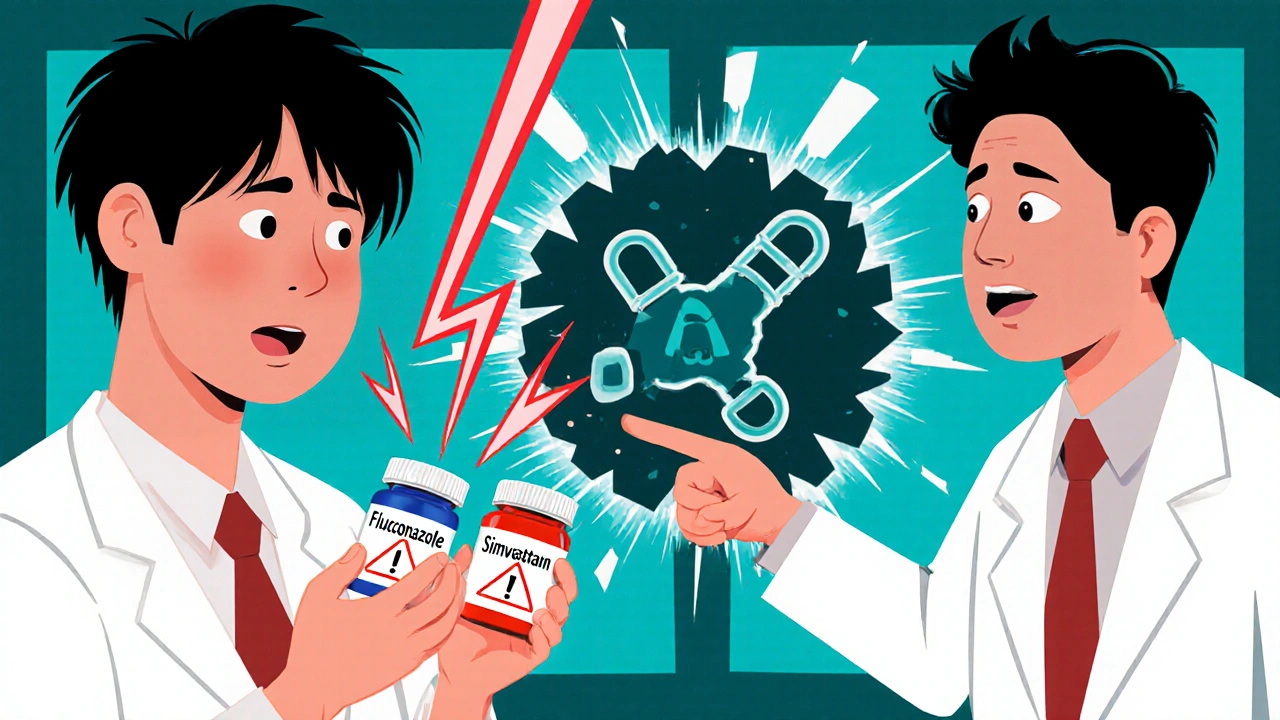
Antifungal-Statins Interaction Checker
Check if your combination of antifungal and statin is safe. Based on the latest clinical guidelines.
Safety Result
High Risk Interaction
This combination can cause serious muscle damage, kidney failure, or life-threatening conditions.
Recommended Action:
Stop the statin completely while taking this antifungal. Do not restart until at least 24-30 hours after your last antifungal dose.
Alternative Options:
Consider switching to pravastatin or rosuvastatin at low doses (5-10mg) while monitoring closely. Check with your healthcare provider for appropriate alternatives.
When you’re taking a systemic antifungal like fluconazole or itraconazole for a stubborn fungal infection, you might not think twice about your cholesterol pill or transplant medication. But combining these drugs can be dangerous-sometimes life-threatening. The real risk isn’t just theoretical. It’s happening in clinics and pharmacies right now, often because neither the patient nor the prescriber fully understands how these drugs behave together inside the body.
Why Azole Antifungals Are Such Powerful Interactors
Systemic antifungals, especially the azole class, don’t just kill fungi. They also mess with your body’s natural drug-processing system. These drugs block an enzyme called CYP3A4, which is responsible for breaking down about 30% of all medications you take. That includes statins like simvastatin and atorvastatin, and immunosuppressants like cyclosporine and tacrolimus.Think of CYP3A4 as a factory worker who clears out old, used parts. When azoles shut that worker down, those drugs pile up. The result? Toxic levels in your blood. Ketoconazole and posaconazole are the worst offenders-they can make statin concentrations spike by 10 times or more. That’s not a small bump. That’s a red flag.
Which Statins Are Most at Risk?
Not all statins are created equal when it comes to drug interactions. The ones that rely heavily on CYP3A4 for metabolism are the most vulnerable:- Simvastatin - High risk. Even low doses become dangerous with azoles.
- Atorvastatin - High risk. Still commonly prescribed, even with antifungals.
- Lovastatin - High risk. Almost never safe with strong CYP3A4 inhibitors.
- Pravastatin - Low risk. Mostly cleared by the kidneys, not the liver.
- Rosuvastatin - Low risk. Minimal CYP3A4 involvement.
- Fluvastatin - Low risk. Uses different enzymes.
Here’s the catch: even pravastatin and rosuvastatin aren’t completely safe. Ketoconazole can block the OATP1B1 transporter, which helps move these statins out of the liver. That means their levels can still rise-just not as dramatically. So if you’re on ketoconazole, even these "safer" statins need close monitoring.
Immunosuppressants Make Things Worse
If you’ve had a kidney, liver, or heart transplant, you’re likely on cyclosporine, tacrolimus, or sirolimus. These drugs aren’t just immunosuppressants-they’re also CYP3A4 inhibitors. That means they’re doing the same thing as azoles: slowing down statin breakdown.Studies show that when statins are taken with cyclosporine, their blood levels can jump 3 to 20 times higher than normal. That’s why transplant patients have up to a 25% chance of developing muscle pain or weakness. In severe cases, this turns into rhabdomyolysis-where muscle tissue breaks down and floods the bloodstream with toxins that can shut down your kidneys.
One documented case had a patient with creatine kinase (CK) levels over 10,000 U/L. Normal is under 200. That’s not a lab error. That’s a medical emergency.

What to Do When You Need Both
You can’t always avoid antifungals. Fungal infections in immunocompromised patients can be deadly. And you can’t just stop statins if you have heart disease. So what’s the solution?Step 1: Stop the high-risk statins. If you’re on simvastatin, atorvastatin, or lovastatin, pause them entirely while taking ketoconazole, itraconazole, or posaconazole. Don’t just lower the dose-stop it. Posaconazole sticks around in your system for days after you stop taking it. Wait at least 24 to 30 hours before restarting your statin.
Step 2: Switch to a safer statin. Use pravastatin or rosuvastatin instead. Keep the dose low: 10-20 mg daily for rosuvastatin, 10-40 mg for pravastatin. Even then, monitor for muscle pain, dark urine, or weakness.
Step 3: Check your CK levels. If you’re on both an immunosuppressant and a statin, get your creatine kinase checked every 4-6 weeks. If CK rises above 10 times the upper limit of normal, stop the statin immediately.
Step 4: Monitor immunosuppressant levels. Azoles can also raise cyclosporine and tacrolimus levels. Your doctor should check trough levels and lower them by 30-50% when you start an azole antifungal.
What About Newer Antifungals?
Not all antifungals are created equal. Fluconazole is a moderate CYP3A4 inhibitor-it’s less risky than ketoconazole but still requires caution. Voriconazole and itraconazole are strong inhibitors. Posaconazole? Extremely strong. But newer options like isavuconazole and olorofim are changing the game.Isavuconazole, approved in 2015, only moderately inhibits CYP3A4. It’s safer than older azoles, though statin doses still need adjustment. Olorofim, still in trials, doesn’t touch CYP enzymes at all. It works by blocking a completely different fungal pathway. If approved, it could be a game-changer for transplant patients who need long-term antifungal coverage without giving up their statins.

Why Do These Interactions Keep Happening?
You’d think this would be obvious. But studies from 2012 show that doctors still prescribe simvastatin with azoles far too often-even though the labels warn against it. Why?First, statins are everywhere. Nearly 39 million Americans take them. Fluconazole alone is prescribed over 5 million times a year in the U.S. Second, most primary care doctors aren’t specialists in drug interactions. They see a fungal infection and write a script. They don’t always check the statin list.
Electronic health records have helped. In academic hospitals, decision support tools cut dangerous combinations by 47%. But in community clinics? Not so much. Pharmacists are stepping in. At 87% of academic medical centers, pharmacists now verify every azole prescription against the patient’s statin list. That’s reduced risky combinations by 63%.
Genetics Play a Role Too
Some people are naturally more at risk. About 12% of the population has a gene variant called SLCO1B1. This affects how well your body moves statins into the liver. If you have this variant and you’re on a CYP3A4 inhibitor, your risk of muscle damage jumps significantly.Right now, we don’t routinely test for this. But in the future, it might become standard-especially for transplant patients or those with a history of statin-related muscle pain. Genetic testing could help doctors pick the right statin before the first pill is even taken.
Bottom Line: Know the Rules, Ask the Questions
If you’re taking a systemic antifungal, ask your doctor or pharmacist:- Which statin am I on? Is it simvastatin, atorvastatin, or lovastatin?
- Should I stop it while I’m on this antifungal?
- Can I switch to pravastatin or rosuvastatin instead?
- Will my immunosuppressant levels need checking?
- What symptoms should I watch for-muscle pain, weakness, dark urine?
Don’t assume your doctor knows. Don’t assume your pharmacist checked. Take control. These interactions are preventable. But only if you speak up.
Can I take fluconazole with my statin?
Fluconazole is a moderate CYP3A4 inhibitor, so it’s less dangerous than ketoconazole or itraconazole. You can usually take it with pravastatin or rosuvastatin at standard doses. But if you’re on simvastatin, atorvastatin, or lovastatin, you should avoid fluconazole or switch to a safer statin. Always check with your pharmacist before combining them.
What happens if I accidentally take simvastatin with itraconazole?
You significantly increase your risk of rhabdomyolysis. Symptoms include severe muscle pain, weakness, and dark, tea-colored urine. Stop the statin immediately and call your doctor. You may need blood tests for creatine kinase and kidney function. Even if you feel fine, don’t wait-this can progress quickly.
Is it safe to take rosuvastatin with posaconazole?
Rosuvastatin is one of the safest options, but it’s not risk-free. Posaconazole can still raise rosuvastatin levels slightly by blocking the OATP1B1 transporter. Use the lowest effective dose-5 mg or 10 mg daily-and monitor for muscle symptoms. Avoid doses above 20 mg while on posaconazole.
How long should I wait after stopping an azole before restarting a statin?
For most azoles like fluconazole or itraconazole, wait 3-5 days. For posaconazole, wait at least 24-30 hours after your last dose because it stays in your system longer. If you’re unsure, ask your pharmacist to check the half-life of the specific antifungal you took.
Do I need to stop my immunosuppressant if I need an antifungal?
No, you don’t stop the immunosuppressant. But you do need to adjust its dose. Azoles can raise immunosuppressant levels, increasing the risk of kidney damage or infection. Your transplant team should check your blood levels and reduce your dose by 30-50% when you start the antifungal. Never adjust this yourself.
Are there any statins that are completely safe with all antifungals?
No statin is 100% safe with every antifungal. But pravastatin and rosuvastatin are the safest choices overall. They’re not metabolized by CYP3A4, so they avoid the biggest interaction pathway. Even so, ketoconazole can still affect them via the OATP1B1 transporter. Always use the lowest effective dose and monitor for side effects.
Can I use over-the-counter antifungals like clotrimazole with statins?
Topical clotrimazole (creams, sprays) is generally safe because very little gets into your bloodstream. But avoid oral forms like ketoconazole tablets or suspensions. Even though they’re sometimes sold OTC in other countries, they’re prescription-only in the U.S. for good reason-systemic absorption can trigger dangerous interactions.
Drug interactions like these aren’t rare accidents-they’re predictable, preventable, and too often ignored. If you’re on a statin and need an antifungal, don’t guess. Ask. Check. Confirm. Your muscles-and your kidneys-will thank you.
14 Comments
Write a comment
More Articles

Understanding the Different Types of Headaches: A Complete Guide
A comprehensive guide that explains every major headache type, symptoms, triggers, and treatment options so you can manage pain and know when to seek help.

Diovan Uses, Side Effects & Real-World Patient Tips for Better Blood Pressure Control
Diovan is a widely prescribed medicine for controlling high blood pressure. This article uncovers how Diovan (valsartan) works, its real impact on heart and kidney health, and what to watch for in daily life. Expect useful tips, guidance, and actual numbers from clinical research. Whether you’re considering Diovan or managing your dose, this read explains what other guides leave out.

TSA Guidelines for Flying with Prescription Medications: What You Need to Know in 2025
Learn exactly how to fly with prescription medications in 2025 under TSA rules - including what’s allowed, what gets confiscated, and how to avoid delays at security. Essential for travelers with insulin, CBD, ADHD meds, or other prescriptions.
Nicole Ziegler
November 20, 2025 AT 07:17bro just took fluconazole with my 20mg rosuvastatin and felt fine 🤷♀️ but now i’m paranoid every time i pee 🫠